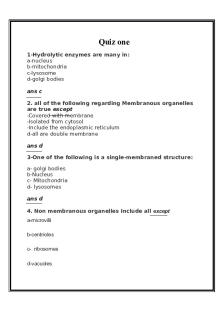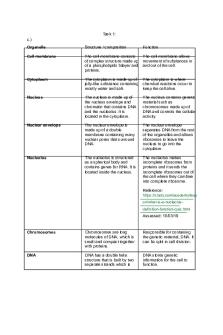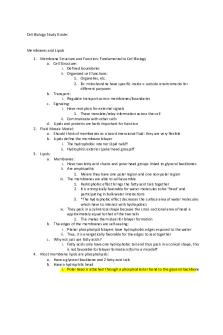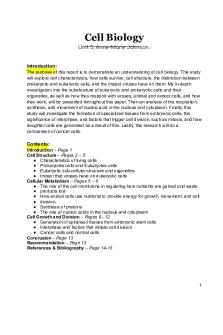Cell Bio Cheat Sheet - Summary Cell Biology and Genetics PDF

| Title | Cell Bio Cheat Sheet - Summary Cell Biology and Genetics |
|---|---|
| Author | Simon Birezl |
| Course | Cell Biology and Genetics |
| Institution | University of Technology Sydney |
| Pages | 4 |
| File Size | 679.2 KB |
| File Type | |
| Total Downloads | 9 |
| Total Views | 159 |
Summary
Used for exam paper....
Description
Hooke Theory; basic unit of life, come from pre-existing cells, all organisms are made up of one or more cells. Cell= lowest level of organisation that can perform life activities- single c. (bact, protoz), multi-c (pl and an) Cells small- need high SA:Vol rat. Cell size inc., vol inc. 10x faster than SA. Taxonomy- classifies species into groups of inc. breadth; Domain Bacteria, ‘’Archaea, ‘’Eukarya. Types of c. prokary v eukary. Prokary- nucleoid (chromosomal DNA), no nuc. Membrane, circular+double strabded, plasmids frequ transmitted. – cytop, ribo, capsule, cell wall, membrane. Cytop (gel-like matrix consisting water, enzymes, nutrients, wastes..Ribos sites of protein synthesis. C.Membrane-permeability barrier. Bact cell wall-composed of peptidoglycan-polymer of amino sugars uthat is linked at regular intervals to short peptides. Capsule- (mainly polysaccharide) encloses the cell wall is some bacterial cells. BACTERIUM- Pili (longer)- hair like structures that help adhere to other cells during bacterial conjugation-transfer of DNA. Fimbriae shorter, help cells adhere to surfaces such as animal cells. Flagella made of a protein called flaggellinlocomotion. +Prokaryotes live close but not multi-cellular. SHAPE AND SIZE- Spheres (cocci), Rods (Bacilli), Spirals (Spirillium), Curved (Vibrio). Two types of prokaryotes; 1) Bacteria-cell walls contain peptidoglycan. Sugar polymers cross linked by polypeptides. 2) Archaea- contain polysaccharides and protein but lack peptidoglycan. EUKARYOTIC C. organism contains genetic info within cell compartment called a nucleus. FLUID mos- double layer of phopholip w/cholesterol, proteins and carbs. Not a static sheet of molecules. Selectively permeable boundary between the cell and environment. NUC of Euk- contains most of the genes, stores DNA, DNA associated w/proteins—chromatin— condenses prior to cell dividion—chromosomes. ENVELOPE- separates from cytop., nuc mem-double mem-phospholip bilayer. Transmission+Express of genetic info-chromosomes consist of DNA and associated proteins-store genetic code. Chromatin is non-condensed form. When cells divide, DNA condenses to chromosomes. Endomembrane Syst. Interconnected syst of membrane enclosed compartments; er, golgi, lysosomes, nuc env, vacuoles, plasma membrane. ER:Bioynthetic Fact; smooth ER – synthesis of lipids, calc.storage, detoxif., lacks ribosomes. Rough ER- memnranes, ribosome attached. –snythesis of proteins and distributed into transport vesicles. Ribosomes; made of ribosomal RNA and protein, found in cystol. Carries out p.synthesis- in cystol, nuc envelope or outside ER. Vesicles moving from ER to Golgi- Receives protein containing vesicles from RER. Modifies, concentrates, packages+sorts proteins. Attaches carb to protein+modifies other carb. Attached to protein. Synthesis of some polysaccharides for the plant cell wall. Lysosomes; digestive sac for proteins, fats+carbs. Transports undigested material to cell memb for removal destroys cells or foreign matter that has been engulfed by phagocytosis. Contains enzymes ot break down macromolecules. Vacuoles Membrane Bound Structures; FOOD VACUOLES- formed by phagocytosis. CONTRACTILE VACUOLES- found in many freshwater protists, pump excess water out of cells. CENTRAL VACUOLES- found in many mature plant cells, hold oganic compounds and water. Mitochindria generates ATP. Chloroplasts chlorophyll- site of photosynthesis. Inner membrane arranged in stacks (granum). Chloroplasts contain ribosomes+DNA; light energyATP + Sugars. Thylakoids: membranous sacs within inner membrane of chloroplasts. Grana- stacks of thylakoids. Cytoskeleton Flexible, dynamic lattice of fibrous proteinsalso called filaments; mechanical support+support structure, intracellular transport of materials, suspension of organelles, contraction, cell motility. FILAMENTS(biggest=microtubule) (smallest=microfilmament)(intermediate fila). Extracellular structures; Cell walls The carbohydrates in the cell wall vary dependent on cell type; - plant/protest-cellulose and Fungi-chitin. Middle lamella, holds cell walls of adjacent cells together. +Cell wall distinguishes plant cells from animal cells. – protects cell, maintains shape, prevents excessive uptake of water. Extracellular Matrix; surrounds animal cells, composition; glycoproteins+fibrous proteins such as collagen, holds cells together in tissues, contributes to properties of bone,cartilage, skin etc. Filters materials passing between diff tissue, orients cell movements in developments+tissue repair. Plays a role in chem signalling. Intercellular Junctions- Plasmodesmata – channels that perforate plant cell walls. Water and small solutes pass through this. Tight Junctions- membranes of neighbouring cells (animal) are pressed together preventing leackage of extracellular fluid. Gap Junctions- provide cytoplasmic channels between adjacent cells, connexion (6 mem pore); allows transport of ions, water, etc. Desmosomes- fasten cells together in strong sheets. ‘cadherins’- specialised adhesion products. DNA(replication)(transcription)RNA(translation) polypeptide. Scrip- Information coded in the sequence of DNA nucleotide bases, is passed to RNA sequence. Slat-Information in RNA is passed to polypeptide. RNA=Ribose//DNA=Deoxyribose. Hydrogen bonds are anti parallel-5’-3’. DNA and RNA are nucleic acids. Building blocks of them are nucleotides. Each is composed of a 5-carbon sugar (deoxyribose & ribose), a phosphate (PO4) and a nitrogen-containing base that may be a purine (Adenine/ Guanine) or a pyramidine (Thymine DNA/Uracil RNA & Cytosine)Nucleotides connect to form chain of polymers. Bond between adjacent nucleotides is a phosphodiester bond, formed between the 5’-phosphate ground of one nucleotide and the 3’-OH of the next. Prok v Euk Chromosome. Prokaryotic- singular, circular. Eukaryotic- Multiple, Linear. Structure Nucleotides: 2 sugar-phosphate backbones. Nitrogenous bases face toward the interior of molecule. Bases form hydrogen bonds with complementary bases on the opposite sugar-phosphate backbone. 2 DNA strands held together by hydrogen bonds between bases on opposite strands. Pattern = complementary.RNA-Single Stranded. tRNA brings aa to mRNA for protein synthesis. RIBOSOMAL RNA translates mRNA to protein.Basic steps of DNA Replication- 1) Initiation- Begins at an origin of replication. 2) Elongation- new strands of DNA are synthesised by DNA polymerase 3) Termination- different in eukaryotes+prokaryotes. DNA rep is SEMI-CONSERVATIVE. Enzymes involved with DNA Replication in Prokaryotes Helicase- Unwinds parental double helix at replication forks. Single-Stranded Binding Protein- Binds to and stabilises single-stranded DNA until it is used as a template. Topoisomerase- Relieves overwinding strain ahead of replication forks by breaking, swivelling+rejoining DNA strands. Primase- Synthesis an RNA primer at 5’end of leading strand and at 5’end of each okazaki fragment of lagging strand. DNA pol III- Using parental DNA as a template, synthesises new DNA strand by adding nucleotides to an RNA primer or a pre-existing DNA strand. (adds nucleotides to 3’end of daughter DNA strand). DNA pol I- Removes RNA nucleotides of primer from 5 and replaces them with DNA nucleotides. DNA Ligase- Joins okazaki fragments of lagging strand; on a leading strand, joins 3’ end of DNA that replaces primer to rest of leading strand DNA. DNA REPLICATION DNA synthesised in ONLY 5-3. Replication is based on complimentary bases; anti parallel. DNA replication is semi-conservative; new daughter strand stays bound to its parent template. One old strand with one new strand. DNA REPLICATION IN EUKARYOTES Replicated from multiple origins of replication due to complexity. Synthesising the ends of chromosomes is difficult because of the lack of primer. Thus with each round of DNA replication, the linear Eukaryotic chromosome becomes shorter. This is prevented through the action of an additional enzyme – telomerase. MULTIPLE REPLICATION ORIGINS, MUL REP FORKS, MULT REP BUBBLES. RNA primer removed- gap. Chromosome shortened. Mutagens destroys DNA.
CELL DIVISION: A process by which cells replicate or reproduce. MITOSIS- somatic cell (growth and repair. MEIOSIS- sex cell 1-4 nonidentical gametes (reproduction). Daughter chromosomes, half old half new. HUMAN KARYOTYPE; Autosomes=22 pairs, Sex Ch – 1 pair. The centromere contains a specific DNA sequence, to which is bound to discs of proteins called kinetochores. PHASES OF A CELL CYCLE: INTERPHASE G1- primary growth, S-DNA synthesis leading to chromosome duplication, G2secondary growth. MITOSIS, CYTOKINESIS. G1 checkpoint- determines whether all conditions are favourable for cell division to proceed e.g. size, DNA integrity, etc. G2 checkpoint- is to ensure that all of the chromosomes have been accuratel replicated without mistake or damage. M checkpoint- the spindle checkpoint, determines whether all the sister chromatids are correctly attached to the spindle microtubules. G2 of Interphase- chromosomes, in the form of chromatins, duplicated during S phase, cannot be seen because they are not yet condensed. Two centrosomes have formed by replication. Phases of Mitosis PROPHASE- Chromatin fibres condensed, two identical sister chromatids, mitotic spindle begins to form, centrosomes move away from eachother. PROMETAPHASE- Nuclear membrane fragments, microtubules attached to the kinetochores. METAPHASE- chromosomes align at metaphase plate between two poles of the spindle. ANAPHASE- Sister chromatids move towards opposite ends, non-kinetochore microtubules lengthen, two ends of the cell have complete sets of chromosomes. TELOPHASE- two daughter nuclei begin to form. CYTOKINESIS- formation of the constriction belt or contractile ring from microfilaments, cleavage of ell into two identical halves. Coordination of Cell Division: A multiceullar organism needs to coordinate cell division across different tissues and organs. CRITICAL for normal growth, development and maintanence. coordinate timing of cell division coordinate rates of cell division not all cells have the same cell cycle. Cell Cycle Controlled by CHECK POINTS Two irreversible events in cell cycle; - replication of genetic material – separation of sister chromatids. G1 CHECKPOINT Can DNA synthesis begin? –most critical, primary decision point. “restriction point”. If a cell receives GO signal, it divides; internal signals- cell growth, cell nutrition. External Signals: Growth Factors. if a cell does not receive GO signals, it exits the cycle and switches to G0 phase (nondividing, working state. G0 PHASE non-dividing, most human cells in G0 state. Cell Cycle Signals Cdk’s- Cycklin Dependent Kinases. Phosphorylates cellular proteins (activates+inactivates proteins). Cyclins- regulatory proteins; levels cycle in the cell. Cdk-Cyclin Complextriggers passage through different stages of cell cycle. CDKS POSITIVELY REGULATED BY CYCLINS- A cyclin promotes synthesis of next cyclin that I turn, promotes destruction of the previous one. Reg actin are indirect. LENGTH CELL CYCLE (frog embryo=30 min, Intest=12 hr, Liver cells=1 year). PART 2 MEIOSIS (making gametes, creating variation). Genome – total collection of genetic information in cell. Gene: DNA sequence template to assemble a specific protein. Chromatin: set of chromosomes each complexed with protein molecule. Pairs are inherited. Homologous – genes from the same protein are found in same location. Alleles – two version of each gene.Diploid cells: contains pairs of chromosomes. Haploid cell: contain only one of each pair of chromosomes. eesmata
Total Body Water Volume: 40L, 60% body weight.
Intracellular fluid volume- 25L, Interstitial fluid Volume=12L, extracellular fluid. Plasma 20% extracellular fluid. *Extracellular fluid vol. 15L, 20% bodyweight. POLARITY OF WATER Water is a polar molecule, opp ends have opp charges. Polarity allows water mol to form hydrogen bonds with each other. FOUR EMERGENT PROPERTIES OF WATER: - Cohesive Behaviour, Ability to moderate Temperature, Expansion upon Freezing, Versatility as a solvent. COHESION: H BONDS hold water molecules togethercohesion. Cohesion helps transport of water against gravity. ADHESION attraction between different substances water and plant cell walls. SURFACE TENSION How hard is it to break surface of a liquid. It is a property of the surface of a liquid. Surface tension related to cohesion. --Molecules in a liquid have a certain degree of attraction to eachother (cohesion). Molecules at the air/water interface has a larger attraction towards liquid phase than air or gas. Therefore, air/water interface will spontaneously minimise its area and contract. ANY factor which decreases the strength of this interaction will lower surface tension. INC TEMP DECRE SURFACE TENSION. ANY CONTAMINATION (SURFACTANTS), DECREASE SURFACE TENSION. MODERATION OF TEMPERATURE; -Water absorbs heat from warmer air and releases stored head to cooler air. –Water can absorb or release a large amount of heat, with only a slight change in its own temp…A calorie= amount of heat required to reaise temp. of 1g of water by 1C. Joule =0.239 cal, or, 1 Cal =4.184J. specific heat of water is 1cal/g/C. H2O resists changing its temp because of HIGH SPECIFIC HEAT. TRACE TO H BONDING. – heat is absorbed when H bonds break. – heat is released when H bonds form. EVAPORATIVE COOLING Evaporation is a liquid to gas. Heat of vaporation= heat a liquid must absorb for 1ggas. As evap occurs, remaining surface cools. Evap cooling of water helps stabilise temp in organisms and bodies of water. WATER IN SOLID STATE Ice floats because; H bonds are ordered, less DENSE. GREATEST dentsity at 4C. If ICE SANK, all bodies of water would eventually freeze solid—making life on earth impossible. H-Bonds stable in Ice. Can H bond to 4 other molecules. WATER bonds break and reform, can bond with 3.4 other molecules. WATER; THE SOLVENT OF LIFE; SOLUTION Liquid that is a homogenous mixture of substances. SOLVENT dissolving agent of a solution. SOLUTE sub that is dissolved. AQUEOUS SOLUTION –one in which water is the solvent. +Water is a versatile solvent due to polarity (H Bonds form easily). WHEN IONIC COMP IS DISSOLVED, each ion is surrounded by a sphere of water molecules called a HYDRATION SHELL. +Water Can dissolve compounds that are non-ionic, polar molecules- if they have ionic+polar regions---usually proteins. HYDROPHILIC AND HYDROPHOBIC SUBSTANCES. Hydrophilic- affinity for water. Hydrophobic- doesn’t have affinity for water. E.g. oil, non-polar bonds. Colloid- Stable suspension of fine particles in liquid. FEATURES IMPORTANT TO H2O ATTRACTIVE FORCES BETWEEN WATER MOLECULES (high specific heat, high heat of vaporisation), TENDENCY OF WATER TO IONISE (good solvent). WATER IS A POLAR SOLVENT; MOST biomolecules are hydrophilic as they are polar. Water dissolves polar compound by HYDRATING the IONS. IONS INTERRACT WITH H_BONDS IN water; solute-solute becomes solute-water. What makes water a good solvent: Water is a polar compound (forms H bonds). Water is partially ionised (basis of pH scale). Water may take part in chem reactions. (a prop of imp. To biomolecules). ROLE OF WATER IN REACTIONS ATP from ADP is a condensation reaction; Cleavage of ATP to ADP is a hydrolysis reaction; Formation of proteins from aa’s froming a pep. Bond.; some enzymes hydrolyse substrates; the enzyme trypsin hydrolyses proteins. WATER IS A METABOLITE Degradation of a glucose in metabolism, Energy production by photosynthesis (electron acceptor). H3O+ -- HYDRONIUM ION. OH- -- HYDROXIDE ION. (Bio fluids; pH 6-8) (10 fold difference between 40%. 80% of Volume= 3L,
pH). H2O == H+ + OH-, Kw=(H+)(OH-) = ion oroduct of water. - in pure water concentration of each ion is 10-7M (at 25C). +Strong acids and bases completely dissociate in H2). HCl-NaOH. ALTHOUGH BIOLOGICAL SYSTEMS MAINLY CONTAIN WEAK ACIDS AND BASES. Titrations- measures amount of acid in a solution. BUFFERS A BUFFER IS A SUBSTANCE THAT RESISTS CHANGES IN PH. INTERNAL PH MUST REMAIN CLOSE TO 7, TO MINIMISE H+ AND OH- CHANGE IN CONC. Most buffers consist of an acid-base pair that reversibly combine with H+. WEAK acids and bases are not completely dissociated when dissolved in water. Buffers are mixtures of weak acids and their conjugate bases. ACETIC ACID. CH3COOH//H+ + CH3COO-,,, HA//H+ + A-,,,Ka = dissociation constant. TITRATION CURVE OF WEAK ACID; IF OH- is added to the system, the proton donor releases H+, forming water. The H Ac//HA is less than Ka, so HAc dissociates to restore ==. Conjugate acid/base pair tends to resist changes in pH when small amounts of acids or bases are added. EFFECTS OF A BUFFER IN A PH SYSTEM +WITHOUT A BUFFER, adding of OH- or H+ contributes to pH. Buffers consist of Acids; p donor, and Bases p acceptor. Bicarbonate Buffer. Bufering system in plasma operates at a pH of 7.4. (Increased H+ lactic acid) Increased H2CO3 Leads to increased CO2 in the blood plasma Leads to increased CO2 in lungs. RESULT: CO2 is EXHALED. THE RATE OF INHALING OR EXHALING CO2 ADJUSTS QUICKLY AND KEEPS BLOOD Ph CONSTANT. CHEMICAL ELEMENTS + COMPOUNDS ORGANISMS ARE COMPOSED OF MATTER; (anything that takes up space and has mass, composed of chemical elements). Elements cannot be broken down into other substances by chem reactions. 96- naturally occurring elements. 25 are essential for life. A compound consists of two or more elements in a FIXED ratio. Elements in the Human Body 96.3% Oxygen-65, Carbon-18.5, Hydrogen-9.5, Nitrogen3.3///3.7% Ca, P, K, S, Na, Cl,Mg…..Trace elements; B, Cr, Co, F, I. Atoms and Molecules Only electrons are involved in chemical reactions. The number of electrons in the outer most shell determines the chemical properties of an atom- valence electrons. Interactions of atoms sharing electrons, held by attarctions called chemical bonds. Electron Orbitals –Electrons are NOT found in concentric circles, orbitals, used, as most likely space. Each shell has a particular energy level- gives a specific shape and orientation to each orbital. Chemical Bonds-Ionic When attraction holds ions together it is an ionic bond. Chemical Bonds-Covalent Covalent bond is the strongest type of chemical bond. 2 atoms share one or more outer shell electrons. 2 or more atoms held together by covalent bonds form a molecule…Atoms in covalently bonded molecule continually compete for shared electrons. The attraction for shared electrons is ELECTRONEGATIVITY. THE PULL is equal in NON-POLAR covalent (O—O). Pull is not equal in H2O. Oxygen is highly elextronegative, tends to attract shared electrons more strongly. SHARED ELECTRONS, tend to spend more time near oxyfen. POLAR COVALENT BOND. Hydrogen Bonds :Important in the Chemistry of Life In living organisms, a covalent bond is the strongest bond. Weaker bonds are advantageous. WATER CAN DISSOLVEHYDROPHILIC/CHARGED/POLAR MOLECULES. WATER CANNOT DISSOLVE- HYDROPHOBIC/UNCHARGED/NON-POLAR MOLECULES. LARGE COMPLEX MOLECULES FOLD CHARGED POLAR OUTSIDE, UNCHARGED NON-POLAR INSIDE. Carbon Compounds Cells are 70-95% water, the rest consists of carbon based compounds. Carbon is unparalleled in its ability to form large, complex molecules. PROTEINS, DNA, CARBOHYDRATES + OTHER MOLECULES THAT DISTINGUISH LIVING MATTER ARE ALL CARBON COMPOUNDS. (4 valence electrons). ISOMERS- variants in architecture of a molecule; same molecular formula, different structure. Different function. Structural- differ in covalent arrangement. Geometric- same covalent partnerships, differ in spatial arrangement---inflexibility of double bonds. Entaniomers- mirror images- middle, asymmetric carbon. Attached to 4 atoms. CIS ISOMER- X’s same side, TRANS ISOMER- two X’s opp sides. Carbon Compounds; Functional Groups; HYDROCARBONS= simplest organic mlecules. Functional groups- distinctive properties of organic molecule depend not only carbon skeleton, but molecule bound to skeleton. FUNCTIONAL GROUPS BEHAVW CONSISTENTLY BETWEEN MOLECULES. – number and arrangement give unique properties. Functional groups (R groups) are most commonly involved in chem reactions, which INCREASE MOLECULAR DIVERSITY. Groups; Alcohols and Sugars; Acetic Acid; Fatty Acids; Amino Acids; etc. Carbohydrates: Fuel and Building Material – Diverse group of molecules, energy source/store; component of DNA and RNA....
Similar Free PDFs

Cell biology and genetics
- 12 Pages

Apoptosis - Summary Cell Biology
- 4 Pages

Cell and molecular biology
- 16 Pages

Cell biology summary notes website
- 33 Pages

Cell Biology Quiz CELL ORGANELLES
- 10 Pages

Cell biology
- 3 Pages

Cell Biology Study Guide
- 37 Pages

Cell Biology unit (5)
- 14 Pages

Cell Biology Syllabus 2019
- 5 Pages

Cell biology exam, answers
- 11 Pages

Cell biology lecture notes
- 108 Pages
Popular Institutions
- Tinajero National High School - Annex
- Politeknik Caltex Riau
- Yokohama City University
- SGT University
- University of Al-Qadisiyah
- Divine Word College of Vigan
- Techniek College Rotterdam
- Universidade de Santiago
- Universiti Teknologi MARA Cawangan Johor Kampus Pasir Gudang
- Poltekkes Kemenkes Yogyakarta
- Baguio City National High School
- Colegio san marcos
- preparatoria uno
- Centro de Bachillerato Tecnológico Industrial y de Servicios No. 107
- Dalian Maritime University
- Quang Trung Secondary School
- Colegio Tecnológico en Informática
- Corporación Regional de Educación Superior
- Grupo CEDVA
- Dar Al Uloom University
- Centro de Estudios Preuniversitarios de la Universidad Nacional de Ingeniería
- 上智大学
- Aakash International School, Nuna Majara
- San Felipe Neri Catholic School
- Kang Chiao International School - New Taipei City
- Misamis Occidental National High School
- Institución Educativa Escuela Normal Juan Ladrilleros
- Kolehiyo ng Pantukan
- Batanes State College
- Instituto Continental
- Sekolah Menengah Kejuruan Kesehatan Kaltara (Tarakan)
- Colegio de La Inmaculada Concepcion - Cebu




